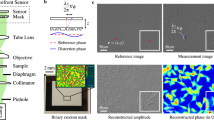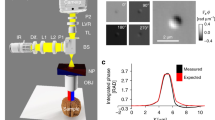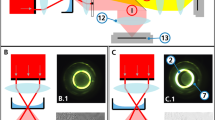Abstract
THE microscope does not reveal detail in uncoloured, transparent specimens even though it is known to be present and of sufficient size to be resolvable. When the detail includes regions of different refractive index, phase differences will be involved in light passing through the specimen, and if these phase differences are changed into intensity differences, the detail may be seen since the eye is sensitive to the latter although not to the former.
Similar content being viewed by others
Article PDF
References
Conrady, A. E., J. Roy. Micro. Soc., 150 (1905). Rheinberg, J., J. Roy. Micro. Soc., 388 (1904); 152 (1905).
Zernike, F., Z. tech. Phys., 16, 454 (1935).
Köhler, A., and Loos, W., Naturwiss., 29, 49–61 (1941).
Author information
Authors and Affiliations
Rights and permissions
About this article
Cite this article
RICHARDS, O. Phase Difference Microscopy. Nature 154, 672 (1944). https://doi.org/10.1038/154672a0
Issue Date:
DOI: https://doi.org/10.1038/154672a0
This article is cited by
-
�ber die Untersuchung lebender Gonokokken mit dem Phasenkontrastverfahren
Archiv f�r Dermatologie und Syphilis (1949)
-
Chromosome structure in relation to the chromosome cycle
The Botanical Review (1948)
-
Golgi Apparatus by Phase Contrast Microscopy
Nature (1946)
-
Phase-Contrast Microscopy for Mineralogy
Nature (1946)
Comments
By submitting a comment you agree to abide by our Terms and Community Guidelines. If you find something abusive or that does not comply with our terms or guidelines please flag it as inappropriate.



